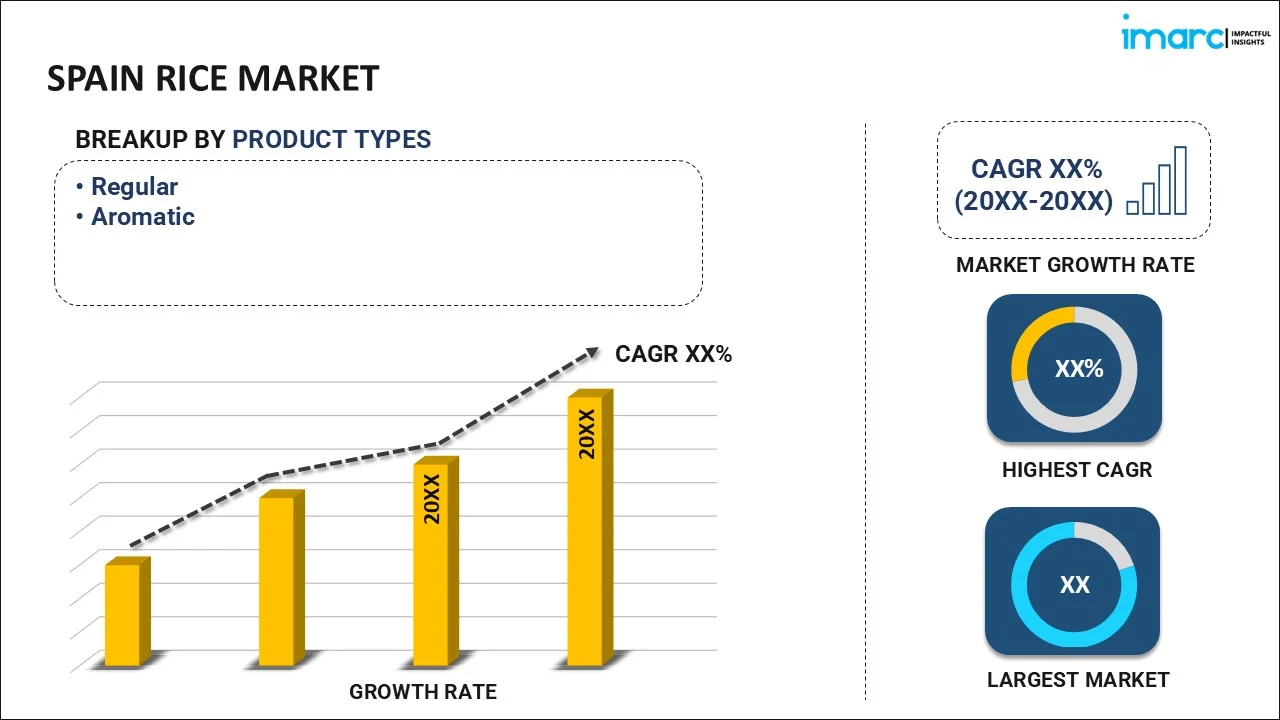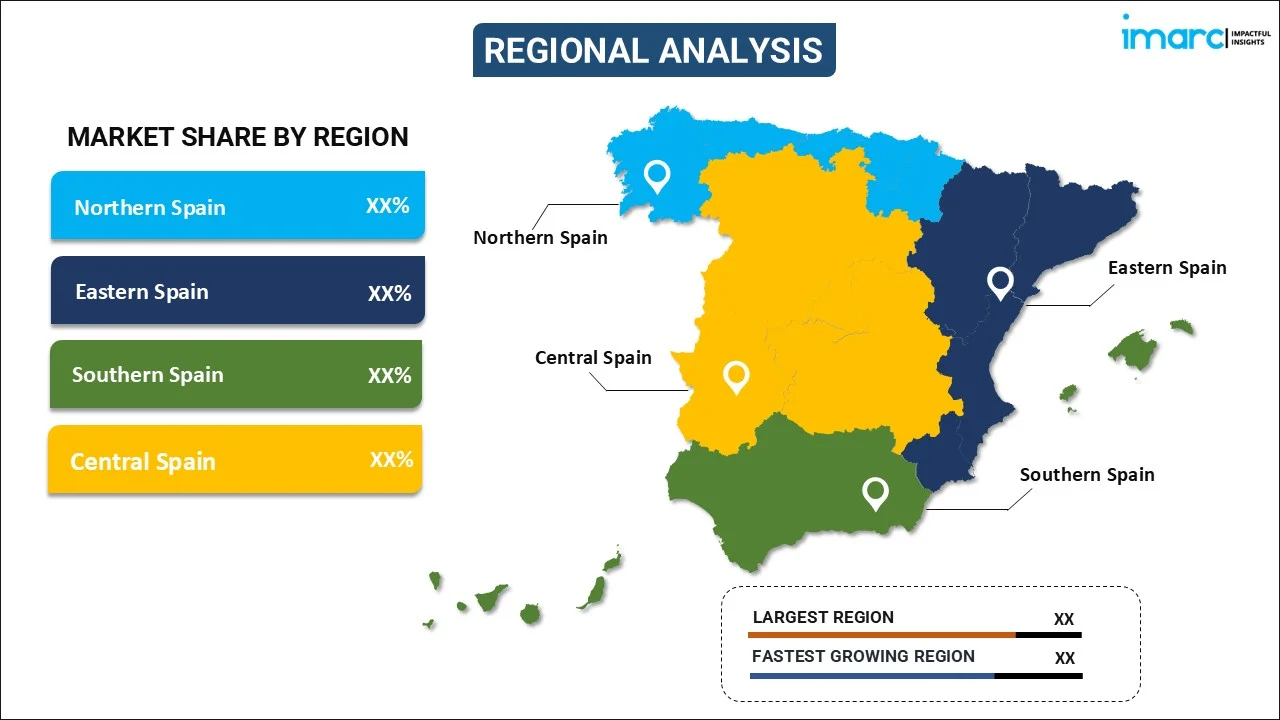
Spain Rice Market Size, Share, Trends and Forecast by Product Type, Type, Grain Size, Distribution Channel, Application, and Region, 2025-2033
Spain Rice Market Overview:
The Spain rice market size reached 292.20 Thousand Tons in 2024. Looking forward, IMARC Group expects the market to reach 419.50 Thousand Tons by 2033, exhibiting a growth rate (CAGR) of 3.70% during 2025-2033. Rising domestic consumption, increasing demand for organic rice, expanding food processing industry, advanced irrigation techniques, climate adaptation strategies, shifting dietary preferences, sustainable farming practices, and technological advancements in milling are driving the growth of the Spain rice market.
|
Report Attribute
|
Key Statistics
|
|---|---|
|
Base Year
|
2024
|
|
Forecast Years
|
2025-2033
|
|
Historical Years
|
2019-2024
|
| Market Size in 2024 | 292.20 Thousand Tons |
| Market Forecast in 2033 | 419.50 Thousand Tons |
| Market Growth Rate (2025-2033) | 3.70% |
Spain Rice Market Trends:
Growing Demand for Organic and Sustainable Rice Production
The rising demand for naturally sourced and organic food products is primarily driving the market growth. This trend fits right into Spain’s bigger goals for being sustainable, which is part of the EU Green Deal. This plan focuses on cutting down on pesticides by half by 2030. It also aims to have 25% of all farmlands be organic. Rice farmers in Spain are changing how they grow their crops. They are using smarter practices that are better for the environment. This includes using fewer chemicals for pests, using less water, and rotating their crops. These methods help keep the soil healthy. The market for organic rice is growing fast. Reports show that sales went up by 12% every year from 2023 to 2025. For instance, Ebro Foods Group is the biggest rice producer in Spain. They have started selling organic rice brands to meet this rising demand. In 2024 alone, they saw a 15% increase in organic rice sales. This growth is also helped by government’s investments that support farmers in switching to organic growing methods and focusing on sustainable rice production methods.
Technological Advancements in Rice Cultivation and Milling
Spain's rice sector is quickly embracing cutting-edge precision agriculture methods to increase yield, decrease water usage, and maximize milling efficiency. A combination of drones, satellite imaging, and AI-based irrigation systems is being used to enhance rice farming in strategic areas like Andalusia, Valencia, and the Ebro Delta. Automated rice milling is being developed in Spain's rice industry to maximize processing efficiency and waste reduction. In 2024, the use of AI-driven milling machines resulted in a 20% improvement in processing efficiency, lowering broken rice production and enhancing quality consistency. Top players like Arrocerías Herba (owned by Ebro Foods) have implemented IoT-enabled storage systems to ensure optimal humidity levels, enhancing shelf life and lowering post-harvest losses by 10%. To counteract climate fluctuation, genetically enhanced varieties of drought- and salinity-resistant rice are also picking up pace. Research centers, in association with the Spanish National Research Council (CSIC), are working to create rice strains using 30% less water, which will guarantee stable production regardless of fluctuating climate conditions. These advances in technology are not just enhancing efficiency but also consolidating Spain's dominance as a prominent rice exporter, especially in the EU and Middle Eastern markets.
Spain Rice Market Segmentation:
IMARC Group provides an analysis of the key trends in each segment of the market, along with forecasts at the region/country level for 2025-2033. Our report has categorized the market based on product type, type, grain size, distribution channel, and application.
Product Type Insights:

- Regular
- Aromatic
The report has provided a detailed breakup and analysis of the market based on the product type. This includes regular and aromatic.
Type Insights:
- Red Rice
- Arborio Rice
- Black Rice
- Grain Fragrance Rice
- Brown Rice
- Rosematta Rice
- Grain Parboiled Rice
- Sushi Rice
- Others
A detailed breakup and analysis of the market based on the type have also been provided in the report. This includes red rice, arborio rice, black rice, grain fragrance rice, brown rice, rosematta rice, grain parboiled rice, sushi rice, and others.
Grain Size Insights:
- Long Grain
- Medium Grain
- Short Grain
The report has provided a detailed breakup and analysis of the market based on the grain size. This includes long grain, medium grain, and short grain.
Distribution Channel Insights:
- Offline Stores
- Online Stores
A detailed breakup and analysis of the market based on the distribution channel have also been provided in the report. This includes offline stores and online stores.
Application Insights:
- Food
- Feed
- Others
A detailed breakup and analysis of the market based on the application have also been provided in the report. This includes food, feed, and others.
Regional Insights:

- Northern Spain
- Eastern Spain
- Southern Spain
- Central Spain
The report has also provided a comprehensive analysis of all the major regional markets, which include Northern Spain, Eastern Spain, Southern Spain, and Central Spain.
Competitive Landscape:
The market research report has also provided a comprehensive analysis of the competitive landscape. Competitive analysis such as market structure, key player positioning, top winning strategies, competitive dashboard, and company evaluation quadrant has been covered in the report. Also, detailed profiles of all major companies have been provided.
Spain Rice Market News:
- September 2024: Neste, along with its value chain partners, is developing regenerative farming practices to reduce the environmental impact of rice production in Spain. The farming practices aim to maintain healthy soil, reduce emissions from agriculture, and promote biodiversity.
Spain Rice Market Report Coverage:
| Report Features | Details |
|---|---|
| Base Year of the Analysis | 2024 |
| Historical Period | 2019-2024 |
| Forecast Period | 2025-2033 |
| Units | Thousand Tons |
| Scope of the Report |
Exploration of Historical Trends and Market Outlook, Industry Catalysts and Challenges, Segment-Wise Historical and Future Market Assessment:
|
| Product Types Covered | Regular, Aromatic |
| Types Covered | Red Rice, Arborio Rice, Black Rice, Grain Fragrance Rice, Brown Rice, Rosematta Rice, Grain Parboiled Rice, Sushi Rice, Others |
| Grain Sizes Covered | Long Grain, Medium Grain, Short Grain |
| Distribution Channels Covered | Offline Stores, Online Stores |
| Applications Covered | Food, Feed, Others |
| Regions Covered | Northern Spain, Eastern Spain, Southern Spain, Central Spain |
| Customization Scope | 10% Free Customization |
| Post-Sale Analyst Support | 10-12 Weeks |
| Delivery Format | PDF and Excel through Email (We can also provide the editable version of the report in PPT/Word format on special request) |
Key Questions Answered in This Report:
- How has the Spain rice market performed so far and how will it perform in the coming years?
- What is the breakup of the Spain rice market on the basis of product type?
- What is the breakup of the Spain rice market on the basis of type?
- What is the breakup of the Spain rice market on the basis of grain size?
- What is the breakup of the Spain rice market on the basis of distribution channel?
- What is the breakup of the Spain rice market on the basis of application?
- What are the various stages in the value chain of the Spain rice market?
- What are the key driving factors and challenges in the Spain rice?
- What is the structure of the Spain rice market and who are the key players?
- What is the degree of competition in the Spain rice market?
Key Benefits for Stakeholders:
- IMARC’s industry report offers a comprehensive quantitative analysis of various market segments, historical and current market trends, market forecasts, and dynamics of the Spain rice market from 2019-2033.
- The research report provides the latest information on the market drivers, challenges, and opportunities in the Spain rice market.
- Porter's five forces analysis assist stakeholders in assessing the impact of new entrants, competitive rivalry, supplier power, buyer power, and the threat of substitution. It helps stakeholders to analyze the level of competition within the Spain rice industry and its attractiveness.
- Competitive landscape allows stakeholders to understand their competitive environment and provides an insight into the current positions of key players in the market.
Need more help?
- Speak to our experienced analysts for insights on the current market scenarios.
- Include additional segments and countries to customize the report as per your requirement.
- Gain an unparalleled competitive advantage in your domain by understanding how to utilize the report and positively impacting your operations and revenue.
- For further assistance, please connect with our analysts.
 Request Customization
Request Customization
 Speak to an Analyst
Speak to an Analyst
 Request Brochure
Request Brochure
 Inquire Before Buying
Inquire Before Buying




.webp)




.webp)












